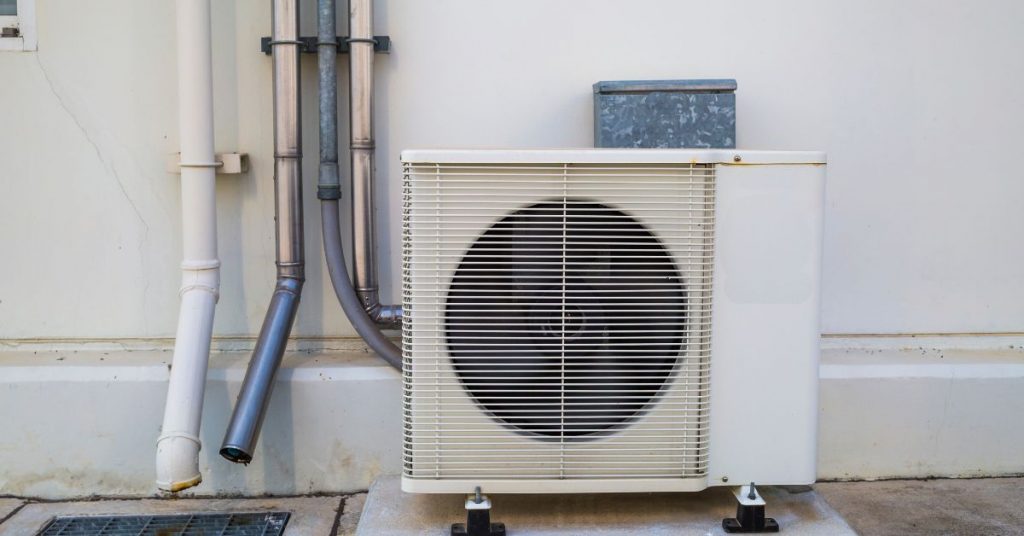
Cleaning your air conditioner (AC) drain line is an essential maintenance task that helps prevent clogs, water leakage, and damage to your AC system. Here’s a summary of the best way to clean your AC drain line effectively:
- Safety Precautions: Before starting, ensure the AC system is turned off to prevent any accidents or injuries. Additionally, wear protective gear like gloves and safety glasses.
- Locate the Drain Line: Find the AC drain line. It’s usually a PVC or plastic pipe that runs from the indoor unit to the exterior or a drainage system.
- Remove the Access Cap or Plug: On the exterior end of the drain line, there may be an access cap or plug. Remove this cap to access the interior of the drain line.
- Use a Wet/Dry Vacuum: The most common and effective method to clear the drain line is by using a wet/dry vacuum. Attach the vacuum hose to the end of the drain line, ensuring a tight seal.
- Create Suction: Turn on the vacuum to create suction within the drain line. This suction will help dislodge and remove any clogs, such as dirt, debris, or algae buildup.
- Listen for Clear Flow: As the vacuum runs, listen for a clear flow of air indicating that the clogs have been removed from the drain line. This may take a few minutes.
- Flush with Water: After using the vacuum, flush the drain line with a mixture of water and bleach (about a cup of bleach per gallon of water). Pour this solution into the drain line to help prevent future algae growth and keep the line clean.
- Reassemble and Test: Replace the access cap or plug on the exterior end of the drain line. Turn on the AC system and monitor the drip pan to ensure proper drainage.
- Regular Maintenance: To prevent future clogs, consider scheduling regular maintenance for your AC system. This can include changing air filters, inspecting the drain line, and having a professional technician perform a thorough AC checkup.
- Professional Assistance: If you’re unsure about cleaning the drain line or if it remains clogged despite your efforts, it’s advisable to seek professional HVAC assistance. They can diagnose and address more complex issues and ensure your AC system functions optimally.
How an AC Condensate Drain Line Works
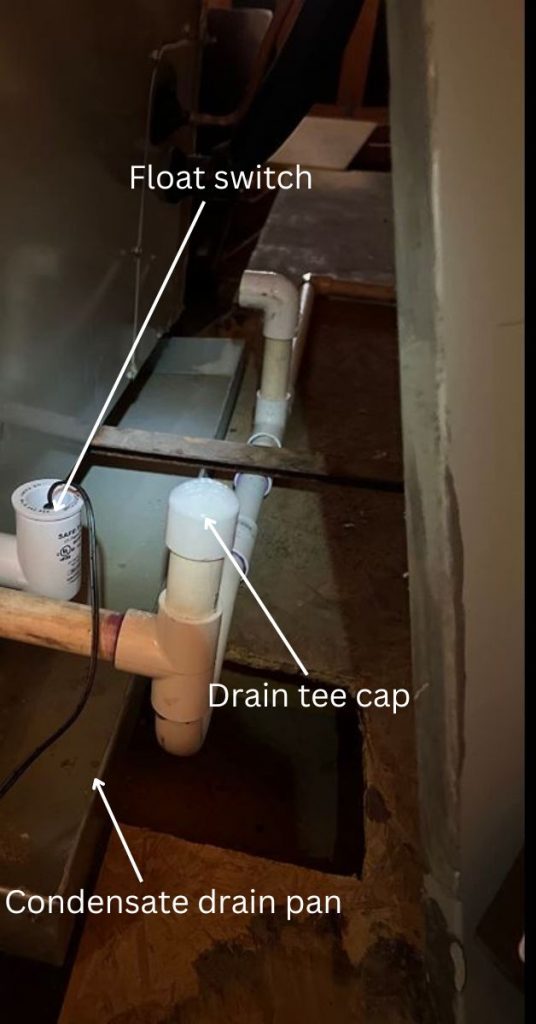
Apart from cooling your indoor air, your air conditioner is also responsible for dealing with the humidity in the house. Both cooling and dehumidification happens on the evaporator coils, which is also known as the AC’s indoor unit.
The refrigerant/coolant enters the evaporator coil as a cold liquid. Warm and humid air from the house is pulled by the fan/blower and when it comes into contact with the coil, the refrigerant absorbs heat from the air.
Cooled air is then forced out and back to the house. The water vapor in the air (humidity) upon contact with the cold coil will condense (turn into liquid water).
To prevent water damage, a tray known as the condensate drain pan is installed under the evaporator coil. The condensate drips on the pan, which is then connected to the condensate drain line.
Note: If you have a horizontal HVAC unit (installed in attics and crawlspaces) you will have a primary drip pan located under the evaporator coil and a bigger secondary drip pan located under the entire unit. The secondary pan is a backup for the primary pan.
Since an air conditioner can produce anywhere between 5 and 20 gallons of condensate in a day, the drain line needs to be clear in order to discharge out all the condensate.
To prevent the drip pan from overflowing when the condensate drain line is clogged, a float switch is installed on the drip pan or drain line.
When the water level in the drip increases more than the allowable limit, the float mechanism of the float switch moves up as well, breaking contact between 2 electric probes. That causes the AC unit to turn off since the electric path is now incomplete.
With the AC off, the evaporator coil can no longer produce more condensate. That is how the float switch protects your house from water damage.
Let us now look at the 3 methods of cleaning an air conditioner drain line:
1. How to Clean an AC Drain Line Using Vinegar
For best results I would recommend that you use distilled white vinegar. Vinegar is a weak acid that will break down gunk inside the AC condensate drain line without damaging it and is also safe for you and the environment.
Here is how to clean the AC drain line using vinegar:
- Turn off the air conditioner from the thermostat and electrical panel. This is to avoid the risk of electrical shock.
- Locate the AC drain pipe access tee vent. That will be a T-shaped PVC piece with a cap at the top.

- Remove the cap from the drain access tee. You actually don’t need to use any tool for that. Just remove it with your hand.
- Now slowly pour out 1 cup of distilled white vinegar down the AC drain line.
- Wait for about 30 minutes for the vinegar to work out its magic.
- Flush the drain line with about a gallon of hot water.
Actually, hot water on its own is enough to clean the AC drain line and there are lots of plumbers and HVAC technician who recommend it. I however like to use it remove and flush out whatever that was left behind by the vinegar.
- Put back the tee cap.
- Turn the AC back on.
- Repeat after 1 month.
Although there are commercial AC drain line cleaners that you can buy and use, vinegar works just fine and is not as expensive.
Is Bleach or Vinegar Better for AC Drain Line Cleaning?
There are some people who will advise you to clean your AC drain line using bleach. So, is bleacher better than vinegar and should you use it?
Bleach is stronger and therefore more effective in clearing drain clogs than vinegar, but you shouldn’t use it. Due to its corrosive nature, bleach will damage you pipes and also eat the metal used to make your AC coils resulting in expensive repairs/replacements.
The AC evaporator coil is made of copper or aluminum. If the bleach gets to the coil, it will corrode it and within no time the coil will develop holes and start leaking out the refrigerant.
Without a refrigerant, cooling cannot happen. You will therefore have to replace the entire evaporator coil which is not cheap.
Bleach clears clogs by producing large amounts of heat. The heat can melt the PVC glues and cement used to connect the AC drain pipes together, causing the condensate to start leaking indoors.
For those reasons, it is better to use vinegar to clean your air conditioner condensate drain line instead of bleach. Don’t even think of using strong acids like sulfuric or muriatic acid. They are worse.
2. How to Clean an AC Drain Line Using a Shop Vacuum
If you can get hold of a shop vac, cleaning the air conditioner drain line will be a simple and fast task for you. The suction force of the shop vac will pull out all the gunk embedded inside the AC drain line.
Here is how to clean an air conditioner drain line using a shop vac:
- Locate your AC drain line outside the house. It will be somewhere on the outside wall of the house, sometimes close to the condenser unit.
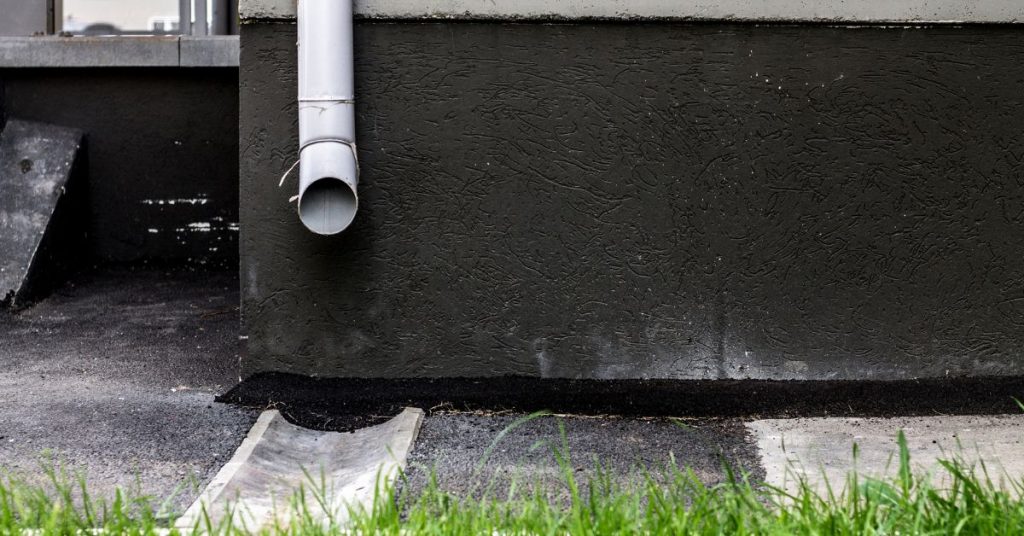
- Connect the shop vac’s hose to the AC drain line. You can use a piece of rag or duct tape to create a tight seal between the hose and the drain line.
- Start the shop vac and let it run for a minute or two.
- As the vacuum is running, dash inside the house and pour some water down the drain line access tee. The water will be sucked out by the vac, alongside any gunk inside the pipe.
- Turn off the vac and drain it out.
- Repeat after every 3 months.
3. How to Clean an AC Drain Line Using a Drain Cleaning Tool
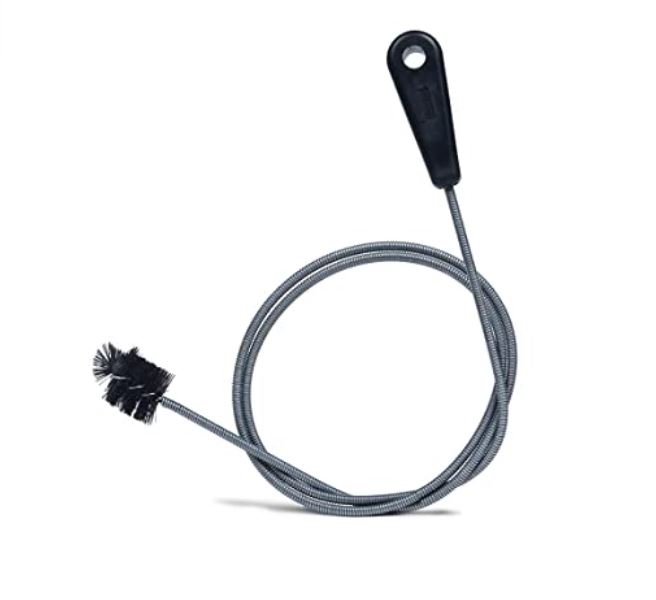
Another way you can clean your air conditioner is by using a brush on a long flexible cable. The brush goes inside the drain line where it breaks off the gunk embedded on the pipes making it easy to flush it out.
These draining tools can be used on other drain lines as well and are therefore specifically not made for cleaning AC drain lines.
What I would advise you is to make sure that you do not but the cheapest one. Some of the tools are not very flexible and can easily get stuck inside the drain line and when you aggressively pull them out they cable will snap leaving the brush inside the pipe.
While feeding the cable down the AC drain line (via the drain line access tee) do it gently, pushing it down and up just to make sure that it doesn’t get stuck.
After you are done cleaning the drain line, flush it out with water.
If you don’t like that tool, another tool you can use is a drain gun. With a drain gun, you will in essence be cleaning the AC drain line using compressed air.
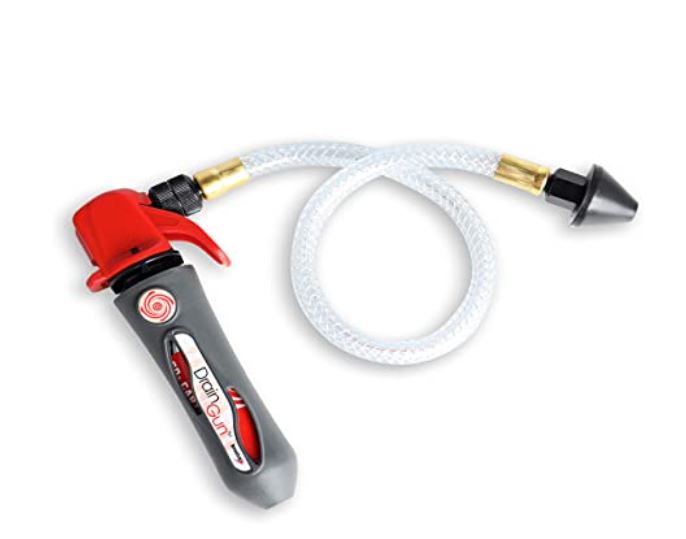
Unlike in the old days when technician needed to bring a tank closer to the air handler in order to use compressed air, a drain gunk is a small tool which uses CO2 cartridges to shoot out compressed air through a cone connected to the front of a short hose.
The cone is designed as such so that it can fit and create a tight seal against drain lines of different sizes. Using a drain gun is easy, you just load it with the cartridge, position the cone on the drain pipe opening and shoot the compressed air down the drain.
You may need to use more than one cartridge to achieve you desired results. The drain gun and cartridges are sold separately so be sure to buy enough cartridges.
Wrap Up
And basically that is how to clean your Air conditioner condensate drain line. I hope that this post was helpful and that you will not have to deal with a clogged AC drain line again.
To prevent most air conditioner problems, have scheduled maintenance by a professional HVAC technician. That way you can take care of minor problems before they blow up and cause expensive repairs or replacements.





